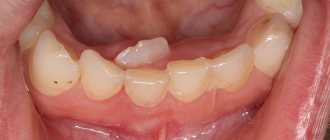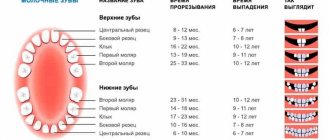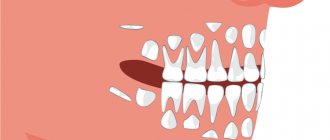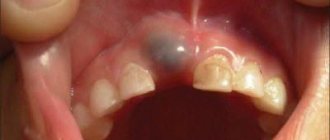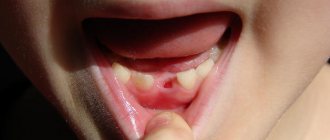Anatomy of permanent teeth
The molar tooth includes three zones: the root, which sits deep in the jaw socket and holds the tooth in place, the neck, located in the periodontal area, and the crown, which extends directly into the oral cavity. After the apex of the tooth appears, a protective film forms on the enamel, the strongest layer of the tooth, which is soon replaced by a salivary layer, formed from the saliva itself. The dental tissues themselves are not just a piece of bone, but a certain heterogeneity, which includes, in addition to enamel, dentin (the main substance of the tooth) and the dental cavity, in which nerves and blood vessels branch. Compared to bones, for example, the phalanges of the fingers, dentin is noticeably stronger - it contains an increased amount of minerals, for example, the same calcium-based compounds. The root zone of dentin is connected to the periodontium using a special layer - dental cement, which communicates with the tissues of the periodontium itself and supplies the dentin with nutrients.
Is it possible to pull out a baby tooth yourself?
You can pull out a tooth yourself only if it barely stays in the socket. Examine the child's jaw for swelling and bleeding. If you have such signs, it is better to visit a dentist. Also, you should not pull out a baby tooth yourself if your child has a cold.
Self-removal occurs as follows. Take a clean cloth and soak it in an alcohol solution. Grab the tooth with it and gently pull it out of the socket until it comes out completely. Rinse your child's mouth. Place clean, treated cotton wool in the hole for 15–20 minutes. Let the child press it well with his teeth. Do not consume food or drinks for 2 hours.
Differences between baby teeth and permanent teeth
The structure of primary and permanent teeth is generally the same, but there are several noticeable differences. Which are better not to neglect:
Baby teeth have whiter enamel, while permanent teeth have a slight yellowish tint. Milk teeth are not as strong as permanent teeth due to the lower percentage of mineral substances. The pulp of baby teeth is wider and thicker, while dentin and enamel are, on the contrary, thinner. This explains the facilitated, spontaneous removal of a shelf tooth - there are often situations when schoolchildren in class independently loosen and remove milk teeth that have served their purpose. In permanent teeth, the length is significantly greater, dominating over their width and cross-sectional area. The root of a baby tooth is thinner and shorter - a person is able to pull out a baby tooth without the help of specialists. Meanwhile, the permanent “embryo” of a real tooth under the shelf one is already ready to grow quickly and be born. The latter is achieved due to the dental gap, which has expanded by the time the non-permanent tooth falls out.
How to behave if your child’s first tooth falls out?
The first baby tooth that falls out is another step towards growing up. So why not mark this event with some interesting ritual for the child, so that further loss will be easier for the baby and bring more joy.
Tooth Fairy
Give your baby a little magic. Let the good sorceress take the first tooth from under the pillow while he sleeps, and in return leave a small gift: candy, a coin or a toy. The next baby tooth that falls out will bring joy to the baby.
Mouse
Another tradition that children really like is to give a lost tooth to a mouse. The mouse will chew the old tooth, and a new one will appear in its place.
Together with your baby, you need to find a secluded corner in the house and put the fallen tooth there. At night, a mouse will run into the corner and take it away.
We hope that falling out baby teeth and emerging permanent teeth will not cause trouble for either children or parents. And to make the first molars give the baby even more joy, we have developed a special Asepta Teens toothpaste to protect and strengthen the enamel of permanent teeth in children over 8 years old. The paste increases the resistance of enamel to bacteria and acids, helps saturate teeth with calcium and phosphorus, and provides effective protection against caries and gum inflammation. And the rich taste of apricot, peach and cream will turn brushing your teeth into a real treat.
Where do teeth come from?
Teeth are formed in the fetus’s body during the mother’s pregnancy. When a mother abused something and undermined her own health, the subsequently born child was guaranteed to have diseased teeth that were no longer permanent. At the 15th week of pregnancy, the mother has hardened dental tissues in the fetus - starting from the crown area and ending with the root zone. The embryos of molar teeth are formed by the 5th month of fetal life. The body of a developing fetus and child is designed in such a way that in the upper jaw the anlage of the permanent teeth is located above the anlage of the milk teeth, and in the lower jaw - vice versa. The formation and development of teeth begins as early as the sixth week of fetal development. The source for them is a special epithelial dental plate. Already by 14 weeks of pregnancy, the unborn baby is actively forming hard dental tissues, initially in the area of the coronal part, and then in the area of the roots of the tooth. When a child is born, primary teeth are the first to grow - by the end of the child's first year of life, they will erupt. However, the dentition contains a group of large molars - they, in turn, do not have milk predecessors and subsequently, when they fall out, grow “on a permanent basis”. Nature has arranged it in such a way that while the child’s jaws are still too small, large molars are not needed there.
Tips for parents - what to do and what not to do
Many parents are concerned about the question of whether it is possible to remove a child’s baby tooth - yes, this can be done independently; it is not at all necessary to visit a pediatric dentist with this problem. To prevent possible complications, it is important to remember to follow the rules of antiseptics and monitor the condition of the hole.
Before extracting a baby tooth from a child, you must ensure that the following conditions are met:
- the milk jug is well loosened in the hole;
- tooth movement back and forth is not accompanied by pain or bleeding;
- there is no swelling or redness of the gums;
- there are no inflammatory processes in the oral cavity - stomatitis, tonsillitis;
- the child is healthy.
Usually temporary teeth fall out on their own without causing problems, but sometimes they can linger in the gums and interfere with chewing food. In such cases, you can try to fix the problem yourself. Ways to remove a baby tooth:
- using a thread;
- fingers.
It is important that the child perceives the manipulation as an adventure, and not a serious procedure, otherwise there is a risk of developing a fear of dental interventions. How to pull a child's tooth:
- For an adult, wash your hands with soap; for a child, brush your teeth and rinse your mouth.
- Place the child so that the light falls on the oral cavity.
- Tie one end of a nylon thread to a loose baby tooth, and wrap the other end around two fingers.
- Pull down sharply if the tooth is located on the upper jaw, or sharply pull up if the milk jug is loose on the lower jaw.
- It is advisable to treat the well with chlorhexidine. If there is blood, apply cotton wool soaked in hydrogen peroxide to the wound - this will help a blood clot form.
- After the procedure, it is important not to eat or drink for 2 hours.
To remove a tooth, wash your hands well with your fingers, take a clean handkerchief, grab the milk jug through it and pull sharply in the direction opposite to its growth (up for the lower tooth and down for the upper). After removal, follow the above processing principles.
What not to do when removing baby teeth in children:
- trying to pull out a loose tooth;
- rush with help - it is necessary to give the child the opportunity to swing the tooth with his tongue, push it out of the socket;
- carry out the procedure with dirty hands;
- tie a thread to door handles, chairs and other objects;
- use tools;
- remove the milk jug with force while holding the child;
- treat the hole or stop the bleeding with alcohol.
If a child is very afraid or in pain, it is better to contact a pediatric dentist.
How many primary and molar teeth does a person have?
In children, the size of the jaw is almost half (in terms of the number of teeth that fit on it) smaller than in adults. Initially, the child has up to 20 teeth - 10 on each jaw. That is, one jaw - 4 incisors, 2 canines and 4 molars. Primary molars have not yet been clearly divided into small and large.
After 16 years, a teenager’s jaws reach approximate sizes that are accessible to an adult. A teenager already has approximately 28-30 teeth, and not 20-24, as before. The number of molars is often represented by 2 small molars and 2 large molars - on each side on each jaw. The last 2 or 4 teeth - “wisdom teeth” usually appear by the age of 20-22 - and a person acquires a full set of teeth, numbering 8 incisors, 4 canines, 8 small molars and 12 large molars - on both jaws in total.
Baby teeth in children
The replacement of baby teeth with permanent teeth in children occurs at the age of 6–7 years. However, there are some deviations from this norm. Let's try to figure out how the change occurs, which teeth are changed and what parents should pay attention to during this process.
A little about anatomy
An interesting fact is that baby teeth begin to form at the earliest stages of gestation. But they usually erupt when the baby reaches six months of age. The question of how many baby teeth children should have is asked by many mothers. Their set differs significantly from the regular ones. For example, if an adult should have 32 teeth, then small children have only 20 milk teeth. Loss begins after the permanent teeth have formed. Basically, this process begins with the lower incisors and takes 6–8 years.
In what order do teeth change?
Over time, the baby grows, and so does his jaw. That is why permanent molars (molars) will appear first - they were absent earlier, because there was simply no room for them.
Next, a complete change of teeth occurs in approximately the same pattern as the growth of baby teeth in children. First of all, the lower incisors sway and fall out painlessly, then the upper ones, after them comes the turn of the premolars (the first pair falls out in children by the age of 10, the second by the age of 12). The last ones to fall out are the fangs; they become loose only by the age of 13. By age 14, a child should already have permanent second molars. After 18 years, third teeth begin to erupt; people call them wisdom teeth.
Many mothers are interested in the question of how many baby teeth fall out in children. They are all completely replaced by permanent ones, that is, 20 teeth must fall out.
How to care and when you may need medical help
If a child complains of severe pain, you note that the gums look inflamed, there is redness, and the enamel is too sensitive - this is a reason to contact a pediatric dentist. In addition, parents should provide the baby with a balanced diet with a sufficient amount of minerals and elements (in particular calcium).
After a tooth falls out, there may be a wound that bleeds (5-10 minutes). To avoid bleeding, you need to make a sterile cotton swab and wrap it with gauze, then give it to your child to bite on. If the bleeding cannot be stopped for a long time, you will have to contact your pediatrician and get tested, as there may be a problem with blood clotting.
Precautionary measures
All teeth require constant care. For example, the enamel of baby teeth is fragile, and if proper monitoring is not carried out, there is a high risk of developing such an unpleasant phenomenon as caries. Then you won’t be able to postpone visiting the doctor. Therefore, the main task of the parent is to choose the correct toothpaste and ensure that the child brushes his teeth regularly.
Many children neglect this action or rush to finish the procedure as quickly as possible. It is necessary to explain to your child that brushing their teeth is a fundamental factor due to which they will be healthy for many years.
When children's baby teeth change, many kids try to loosen them on their own, and especially brave ones even pull them out. Also, the child often touches the cutting tooth with his hands. In these cases, it is necessary to explain to him that performing these actions may ultimately lead to an infection being introduced into the oral cavity, causing the gums to become inflamed. If a growing tooth causes discomfort and pain, a consultation with a dentist is required.
What does the dental formula look like?
The medical record, which the big one keeps in the dental clinic at his place of residence, contains notes about his dental condition. To avoid confusion, doctors number the teeth on each side of each jaw. So, the 1st and 2nd teeth are incisors, the 3rd are canines, the 4th and 5th are small molars (doctors call molars molars), the 6th and 7th are large molars. The 8th - the farthest one - is a “wisdom tooth”; a number of people do not have it, or they do, but not all. Each side of the jaw is also numbered: 1 - top right, 2 - top left, 3 - bottom left, 4 - bottom right. For example, entry 48 does not mean that you are a “Tarkatan” with a combat superset of teeth that does not exist. You simply do not have a “wisdom tooth” on the lower right. Entry 41 - a person lost one of the frontal incisors on the same side on the same jaw. You can write down the formula of the teeth more clearly: for example, “there is no 8th tooth from the bottom right.”
It often turns out that due to lack of space on the jaw, the wisdom tooth develops incorrectly - it can grow crooked, in which case its removal is indicated. For example, it may remain under the gum and, because of this, be affected by caries, which can subsequently develop into pulpitis or a dental cyst. Problematic “wisdom teeth” are quickly and decisively removed, and their absence will not greatly affect the quality of chewing food.
Teething order
The timing of the appearance of permanent teeth to replace lost milk teeth is generally the same for all children and adolescents. After the child turns 5 years old, the first large molars make themselves felt. Then the central incisors are replaced from below, then the same teeth from above, and the lateral incisors from below. At 8-9 years of age, the lateral incisors on top are replaced. From 9 to 12 years of age, all small molars are replaced. At 13, all fangs are replaced. After 14 years, second large molars appear on all sides, which were not there before. By the age of 20-22, “wisdom teeth” finally appear. There are cases when during the rest of their lives they never erupted.
Deviations by timing
Children do not have clear timing for changing teeth by month or day, but the general boundaries of the process are as follows - the first tooth falls out no earlier than 5 years and no later than 8 years, otherwise pathology can be suspected.
Early tooth loss is caused by a lack of nutrients, diseases of the digestive system, and rickets; Often injuries and falls cause the loss of one or two milkmen.
A delay in the change of teeth can be observed with congenital pathologies of the structure of the maxillofacial apparatus, late teething, and chronic infectious processes in the body.
Deviation from the order of loss of baby teeth in children is a reason to seek advice from a dentist and pediatrician.
How to determine that a child will soon have molars?
According to some of the signs, interdental intervals initially increase. This happens due to the growth of the jaw bones - the teeth begin to not fit tightly together, as happens in adults. Then the temporary teeth gradually become loose - due to the gradual disappearance of the temporary root, which can no longer reliably hold such a tooth, and itself is gradually pushed out of the soft and semi-soft tissues on the jaw. The loss of a temporary tooth is a clear sign that the permanent tooth is already growing in full force, and the top of its crown will soon push apart the gum tissue. The appearance of a new tooth is also accompanied by slight redness and swelling. If a child or teenager has a fever, their health has worsened, and their gums hurt, go to the doctor immediately.
No molars
The molars, despite the specific timing specified above, may ultimately not hatch. For example, temporary teeth do not fall out for a long time, and permanent teeth do not grow for a long time after they fall out. At the first stage, the dentist will take an X-ray of the condition of the child or teenager’s jaws. The X-ray machine will clearly project what should grow in place of the supposed teeth, which teeth are ready to hatch, and whether they exist at all. But the problem will immediately become obvious, and the reason for it most likely lies in the physiology of the child, which has undergone some delay. If this is true, be patient: in the end, the teeth will not take long to arrive. But if the picture shows emptiness, you are faced with a complete absence of teeth, the reason for which is a violation of the intrauterine development of the fetus during the mother’s pregnancy. Only prosthetics will help here - artificial insertion of false teeth.
Problems of changing teeth
According to statistics, every tenth child experiences problems of varying severity when changing teeth. The most common deviations are:
- Shark mouth. The molars grow in the second row, while the milk teeth have not yet fallen out and take up space in the jaw. Removal of temporary teeth and correction of the position of permanent teeth are required.
- The milkweed has fallen out, but the root one is not growing. In such cases, an x-ray is prescribed - as a rule, the examination reveals a molar, the growth of which is directed to the side, so it cannot grow in its physiological position. Need help from a dentist.
- Redness, soreness of the gums. Indicates an infection and requires treatment.
Molar tooth hurts
After the molar has emerged from the gums, the “young” tooth enamel is not fully saturated with all the necessary microelements. During this period, the tooth is especially vulnerable: it is strictly forbidden to subject it to overload. It is not for nothing that children are advised not to chew, for example, candy, large quantities of peanuts, or any solid foods. If you neglect this rule, children may immediately develop caries, and this is the path to problems with specific teeth. Caries gradually turns into pulpitis (damage to the internal cavity of the tooth) and periodontitis (damage to the ligaments surrounding the tooth). The child often experiences toothache and poor general health. Without turning to a professional doctor for help in time, parents can lead their child to various consequences - up to the complete loss of a diseased tooth. If a predisposition to the appearance of carious lesions has been identified, their prevention may involve closing the natural deep pockets surrounding the molars. This is done using high-quality composite materials. In this case, food debris will not accumulate in these places, destructive microflora will not develop, and the period of susceptibility to caries will pass when the teenager grows up.
Molars grow crooked
Molars are also subject to crooked growth. They can begin to actively grow before the temporary ones become loose and fall out. Encountering this natural obstacle in the process of their growth, they can grow crookedly than would be intended by nature - they are “led” to the side. If the growth of a molar is detected immediately after a temporary one, this defect leads to a curvature of the bite, which is why the child or teenager will need the help of an orthodontist. In this case, it is necessary to urgently remove the temporary tooth that is interfering with the growth of the permanent one. If time has not yet been lost, it may be possible in this way to remove the predisposition of the same tooth to acquired curvature. Despite the fact that a teenager, having realized the uselessness of a temporary tooth, can independently loosen it and remove it, doctors strongly advise refraining from such a step so that the child avoids, for example, sepsis.
Molars fall out
If molars suddenly begin to fall out suddenly, this is a sign that the child’s health is not in the best condition. Tooth loss is preceded by both systemic diseases (immune problems, impaired development of connective tissue) and local ones (caries, pulpitis, periodontal disease, etc.). Tooth from permanent dentition. When lost, it leaves behind a permanent problem. A radical solution could be a complete insertion of an artificial tooth - but... Before it is carried out, the child will have to use a removable and replaceable prosthesis before he grows up.
Injuries
An accident or incident, such as a fight, can cause a tooth injury. And it doesn’t matter whether a small part has broken off, or the tooth has cracked, as they say, “to the point of bleeding” - the help of a doctor is definitely needed. In some cases, lost dental tissue is replenished. If a tooth is broken into pieces, it will most likely need to be completely removed and a prosthesis replaced every year. And the answer is simple - the dental tissues have not yet fully matured, the body is growing. And it is necessary to take full care of your teeth at such an early age. In case of extension, the operation is performed by introducing composite materials that replace enamel and dentin.
